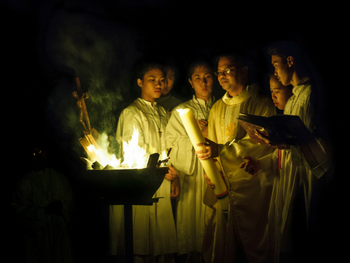
The Paschal Triduum is the center of the liturgical year, and the Easter Vigil is its high point. It is the liturgy at which night turns into day, and death into resurrection.
Why vigil? St. Augustine had a pithy insight into this question: “We now need not wait for the Lord to arrive…. And yet our annual celebration is not simply a commemoration of a past event; it implies a present action on our part, which we accomplish by our life of faith and of which this Vigil is the symbol. The entire course of time is in fact one long night during which the church keeps watch, waiting for the return of the Lord, waiting ‘until He comes.'”
The Easter Vigil is a masterpiece of inculturation. The oldest annual celebration in the calendar, it bears the marks of its creative handling over almost two millennia. Let it wash over you, and lead you into the mystery of Easter tonight.
This liturgy is full of unsuspected delights.


















Easter Vigil & RCIA
Will it possible that, at the Easter Vigil, the Elects’ & Assembly’s Renunciation of Sin & Profession of Faith can combine togehter as one rite, since they are the same?
Sr. Mary-Han, I think it is better that the renunciation of sin and the profession of faith by the Elect be kept separate from the assembly’s responses. The reason I say this is because the elect are making their renunciation and profession for the first time. The assembly is renewing their vows. So even though the text is the same, the context is different.
Note that the rubrics allow for all the elect together to state their renunciation of sin; but that each elect makes his or her profession of faith individually. The importance on the individual’s profession seems to be another reason to keep it separate from the assembly’s renewal of baptismal promises.
Hope that makes sense. Happy Easter to you and your community!
Diana